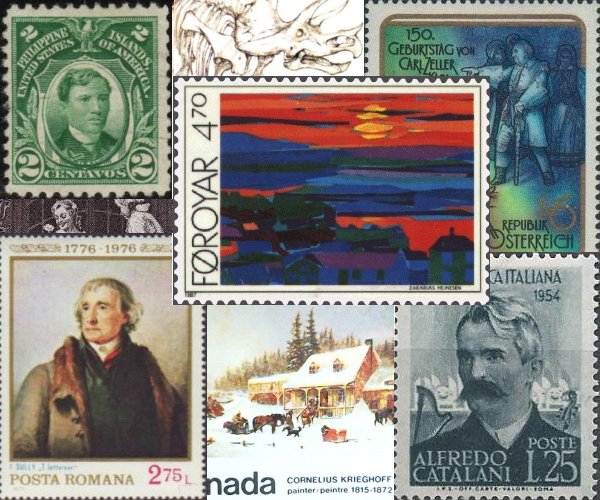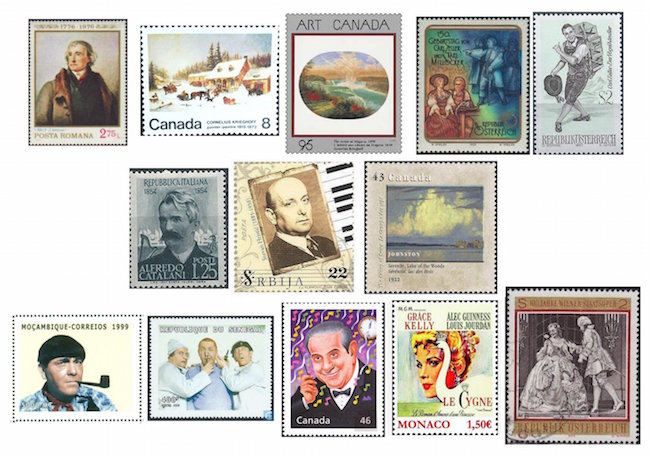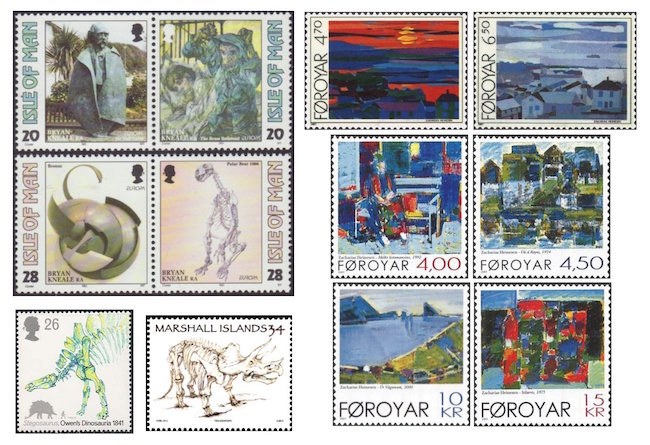The Arts on the Stamps of the World — June 19
An Arts Fuse regular feature: the arts on stamps of the world.

By Doug Briscoe
The astonishing Filipino polymath José Rizal (June 19, 1861 – December 30, 1896) is beloved by his countrymen primarily for his patriotism and sacrifice, but his genius encompassed the arts (he left poetry, two novels, paintings, sculptures, woodcarvings, and more), medicine, specifically ophthalmology, languages (22 of them!), architecture, cartography, economics, ethnology, anthropology, and fencing, among other disciplines. Besides all of this, he was an ardent activist for independence from Spain. For that he was exiled in 1892 to the town of Dapitan, where he oversaw the creation of a school, a hospital, and a water supply system, and took a hand in farming. His association with revolutionaries led to his arrest again in 1896, and in what can only be described as a crime against humanity, the vile reactionaries in power robbed the world of this splendid mind by condemning him to death by firing squad. He was 35. A titan, indeed. He is viewed in the Philippines as a counterpart to George Washington, and naturally many stamps honor him. I offer a few supporting facts to the pictures. The very first Rizal stamp, at upper left, dates from 1906. The third of the small definitives, the brown one, is overprinted “50th anniversary martyrdom of Rizal 1896-1946.” The statue at right in the next row is the work of Swiss sculptor Richard Kissling and dates (the statue, that is) from 1912. The purple stamp in the bottom row cites Rizal’s novel Noli Me Tángere (1887), a work of social importance that was partly inspired by Harriet Beecher Stowe’s Uncle Tom’s Cabin. The next stamp over quotes another of Rizal’s works, the poem “A las flores del Heidelberg“, written as a farewell to Heidelberg University, a plea for his homeland, and a hope for amity between East and West. The third stamp in the row shows José Rizal University, founded as Far Eastern College in 1919 and renamed in 1922. Finally, the only non-Filipino stamp here is one that was issued by Mexico as a token of friendship between the two nations. Personal note: a lovely young home health aide who took care of my mom for a while was a direct descendant of Rizal. Until I met her I’d never heard of him; until she met me she’d never seen the stamps.
There are a number of most interesting facts about the American painter Thomas Sully (June 19, 1783 – November 5, 1872). He was born in Lincolnshire, England to parents who were actors, and he himself appeared on the stage as a tumbler at age 11 (the family had come to America in 1792). At 12 he began painting, learning at first from his relatives: his brother-in-law the French miniaturist Jean Belzons and later his elder brother Lawrence. He also briefly studied with Gilbert Stuart in Boston and Benjamin West in London. When Lawrence died in 1804 Thomas married his widow, took charge of his brother’s children, and gave them a further nine half-siblings to play with. In 1806 he and the family settled permanently in Philadelphia. Sully kept an index of his work, which shows that he painted 2,631 canvases from 1801. Among these are portraits of Thomas Jefferson, John Quincy Adams, Marquis de Lafayette, Andrew Jackson, James K. Polk, and Queen Victoria. The Jefferson piece is seen on the Romanian stamp, one of a set congratulating the US on our bicentenary. Sully’s 1824 Portrait of Andrew Jackson has been used for the United States twenty-dollar bill since 1928 (but will give place to Harriet Tubman in a few years). He also created the design for the obverse of the Seated Liberty coins in various denominations. (The Seated Liberty dollar coin, for example, was minted from 1840 to 1873.) Besides the portraits, there are also landscapes and historical pieces, of which the best known is probably Passage of the Delaware, (1819). You can see it at the MFA. A couple of other notes: Sully wrote a book, Hints to Young Painters, that was published posthumously. One of his grandnephews, his namesake Thomas Sully (1855–1939), was a prominent architect in New Orleans. Sully’s name appears in Edgar Allan Poe’s very short story “The Oval Portrait”. Finally, here’s a link to Sully’s Portrait of the Artist of 1821.

Another painter transplanted from the Old World to the New was Dutch-Canadian artist Cornelius David Krieghoff (June 19, 1815 – April 8, 1872). While Sully was large mostly a portraitist, landscapes, particularly winter landscapes, were Krieghoff’s forte. He was born in Amsterdam to a German father who took the boy to his homeland and who gave him his first instruction in art. Krieghoff came first, not to Canada, but to the US, where he even served in the army from 1837 to 1840, during which time he made sketches of the Second Seminole War, later transmuted into paintings. His interest in native Americans followed him to Canada when he moved to Montreal around 1846. He divided his time between Canada and Europe in the 1850s and 60s and retired to Detroit, where he died at age 56. The two stamps offer The Blacksmith’s Shop (1871) and The Artist at Niagara (1858). An extended biography is on offer here, and for a peek at the man himself see the artists’s Self-portrait of 1855.
The 1992 Austrian stamp that sits next to Krieghoff’s Niagara commemorates the sesquicentennials of both Carl Zeller (19 June 1842 – 17 August 1898) and his compatriot and fellow operetta composer Carl Millöcker. Zeller was a Vienna Choir Boy and later composed while working as a civil servant. He was dogged by ill fortune—arrested for perjury, sentenced to a prison term (though released early), he fell on the ice and spent his final years as an invalid physically and mentally. In 1970 Austria issued a collection of six stamps celebrating operettas, one of which is Zeller’s Der Vogelhändler (The Bird Seller, 1891; there is no connection with Mozart’s Papageno). I suspect that the design is the artist’s imaginary conception of the title character, Adam, but I wonder whether it is perhaps a portrait of a real singer I don’t recognize. Anyone know?

Alfredo Catalani (1854 – 7 August 1893) is one of those composers best known for a single work, in this case the opera La Wally (la vah-LEE, 1892). Toscanini was such an admirer of Catalani’s music that he named one of his daughters Wally. Film mavens may recall the 1981 French film Diva, which made a centerpiece of the aria “Ebben? Ne andrò lontana” from that opera.
Stevan Hristić (1885 – 21 August 1958) studied conducting with Artur Nikisch and went on to become a central figure in Serbian classical music. He was one of the founders of both the Belgrade Philharmonic and the Belgrade Music Academy and acted as the orchestra’s first principal conductor and as one of the first professors of the conservatory, of which he was later president (1943–44). There’s an opera connection here, too: Hristić was director of the Belgrade Opera House from 1925 to 1935.
We’ve already had occasion to see stamps associated with Canada’s Group of Seven, as three members of the artists’ group, Franklin Carmichael, J. E. H. MacDonald, and A. J. Casson, had birthdays in May. Another was Frank Johnston (June 19, 1888 – July 19, 1949), born in Toronto, who, like several of the others, exercised his craft at the Grip Engraving Co., where the group was formed. Johnston, however, left Toronto for Winnipeg to lead the School of Art there, and so left the group. Later he taught at the Ontario College of Art. In 1927, he changed his first name to Franz. The stamp shows his Serenity, Lake of the Woods (1922). Here’s a photo of the artist. The next Group of Seven artist in our survey, Arthur Lismer, is coming up next week.

Well, we acknowleged the birthday of Shemp Howard in March, and now it’s kid brother Moe’s turn. Yes, Moe was younger despite being the Three Stooges’ top dog. Born Moses Harry Horwitz (June 19, 1897 – May 4, 1975) in Brooklyn, Moe Howard’s favorite Stooges picture was the 56th of their 190 shorts, I’ll Never Heil Again (1941), in which he reprised his role as dictator Moe Hailstone of Moronica. He had first portrayed the character in You Nazty Spy! (1940), a few months before Charlie Chaplin’s Adenoid Hinkel. In the Mozambique stamp, Moe assumes a more deliberative mien than one is accustomed to seeing.
Another popular entertainer born on a June 19 was Guy Lombardo (1902 – November 5, 1977). With three brothers he founded The Royal Canadians in 1924; they would sell hundreds of millions of records. Born Gaetano Alberto Lombardo in London, Ontario, he became an American citizen in 1938. His first New Year’s eve broadcast in 1928 started a fifty-year tradition. Lombardo was also a hydroplane speedboat racing enthusiast, winning the Gold Cup in 1946 and remaining US national champion for the next three years. The Canadian stamp is from 1999.
Just a quick word about the late French actor Louis Jourdan (born Louis Robert Gendre; 19 June 1921 – 14 February 2015), who has no stamp of his own, but whose name appears on one from Monaco that reproduces an advertisement or lobby card for the movie The Swan (1956) with Grace Kelly and Alec Guinness (not to mention Agnes Moorehead and Leo G. Carroll).
German soprano Anneliese Rothenberger (1924 – 24 May 2010) has no stamp specifically devoted to her, either, but appears on one commemorating the centennial of the Vienna State Opera in 1969. There she is seen as Sophie to Christa Ludwig’s Octavian in Richard Strauss’s Der Rosenkavalier. She was born in Mannheim and sang throughout Germany and Austria (Salzburg Festival 1954, the year in which she joined the Vienna State Opera). Though best known for her Strauss and Mozart, she also took on a variety of roles in such disparate works as Berg’s Wozzeck, Poulenc’s Dialogues of the Carmelites, and Verdi’s La traviata. She made many recordings.
Two living artists bring today’s presentation to a close. Born earlier was Manx artist and sculptor Bryan Kneale (born 19 June 1930), who started as a painter, then learned welding and turned to sculpture and teaching. The block of Isle of Man stamps shows four of his works, including, at upper left, his statue of writer Hall Caine. The stamp to the right of that one is labeled The Brass Bedstead, but my online searches turn up an entirely different painting dated 1956. Kneale’s fascination with animal skeletons is reflected in his 1986 drawing Polar Bear, as well as in two sets of dinosaur postage stamps he designed for Great Britain (1991) and the Marshall Islands (2015) (we see just one of each). There is a further set of ten Kneale stamps issued by the Isle of Man, but I don’t own it and can’t find a decent-sized image online. Kneale also made a terrific portrait of Charles Laughton. Incidentally, Kneale’s elder brother is the screenwriter Nigel Kneale, who created the character of Professor Quatermass for a BBC TV series in 1953.
Six years younger to the day, Faroe Islander Zacharias Heinesen (born 1936), son of the Faroese poet and polymath William Heinesen, has his studio on a hill overlooking the town and harbor of Tórshavn, understandably a favorite subject, as rendered in the stamps showing his Eystara vág (East Bay, on the 4.70kr value) and Vestara Vág (West Bay, 6.50kr). Of the other four stamps, the 4kr denomination is The Artist’s Mother (1992), the 4.50kr value is Faroese Village (1974), and the 10kr is Úr Vágum (From Vágar, 2000). Zacharias Heinesen has also designed the backs (n.b., not the obverse illustrations) of recent Faroese banknotes. (For another example, see also www.worldbanknotescoins.com.)
Honorable mention today goes to film critic Pauline Kael (June 19, 1919 – September 3, 2001) and novelists Osamu Dazai (1909 – June 13, 1948), Tobias Wolff (born June 19, 1945), and Sir Salman Rushdie (born 19 June 1947).
A graduate of the University of Massachusetts with a B.A. in English, Doug Briscoe worked in Boston classical music radio, at WCRB, WGBH, and WBUR, for about 25 years, beginning in 1977. He has the curious distinction of having succeeded Robert J. Lurtsema twice, first as host of WGBH’s weekday morning classical music program in 1993, then as host of the weekend program when Robert J.’s health failed in 2000. Doug also wrote liner notes for several of the late Gunther Schuller’s GM Recordings releases as well as program notes for the Boston Classical Orchestra. For the past few years he’s been posting a Facebook “blog” of classical music on stamps of the world, which has now been expanded to encompass all the arts for The Arts Fuse.
